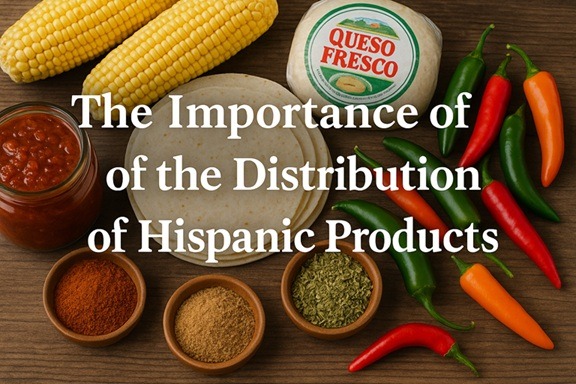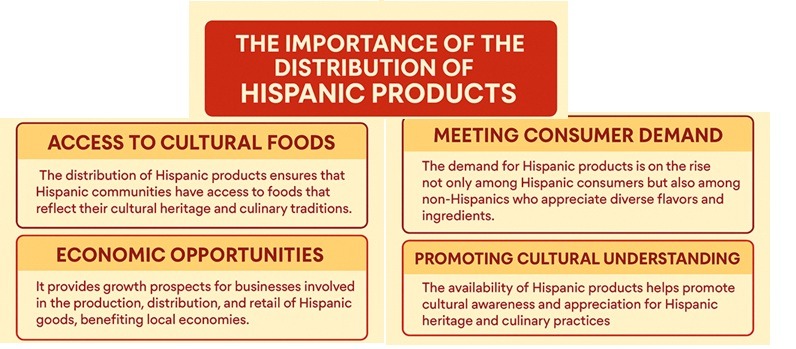
Why Retailers and Distributors must consider Distribution of Hispanic Products
The distribution of Hispanic products has become increasingly important in the global marketplace, particularly in regions like the United States, where the Hispanic population is growing rapidly. The demand for products that cater to the tastes, preferences, and cultural identity of this demographic is rising, creating new opportunities for distributors and retailers. In this article, I explore the significance of distributing Hispanic products, the key factors driving their demand, and the challenges faced by distributors.
Growing Hispanic Population and Economic Influence
One of the key drivers behind the growing demand for Hispanic products is the increasing Hispanic population, particularly in the United States. According to the U.S. Census Bureau, the Hispanic population is one of the fastest-growing ethnic groups in the country, expected to reach nearly 30% of the U.S. population by 2060. Projections indicate that Hispanics will constitute over 22% of the U.S. population by 2028, and their purchasing power is already in the trillions. Efficient distribution allows businesses, from large corporations to small, family-owned enterprises, to tap into this robust market. By ensuring products reach consumers effectively, it stimulates sales, fosters business growth, and creates employment opportunities within Hispanic communities and beyond.
Importance of Hispanic Products

The Role of Retailers and Distributors in the Distribution of Hispanic Products
Retailers and distributors play a critical role in ensuring the distribution of Hispanic products. This includes not only traditional Hispanic stores but also mainstream grocery chains and online retailers. By offering a diverse range of Hispanic products, these retailers can meet the growing demand from Hispanic consumers while attracting non-Hispanic customers who are interested in exploring these products.
Distributors need to be strategic in their approach to the Hispanic market, ensuring that products are available at the right places and at the right times. This requires understanding the cultural nuances, consumption habits, and product preferences that vary from one Hispanic community to another. Additionally, ensuring the proper logistics and supply chains to accommodate the diverse nature of Hispanic products is essential for successful distribution.
Challenges in Distribution of Hispanic Products
Despite the growing demand for Hispanic products, there are challenges in distribution that companies must navigate.
Authenticity: One major issue is ensuring the authenticity of the products. Many Hispanic products are deeply tied to specific regions and cultural practices. Distributors must work closely with manufacturers and suppliers to ensure that the products meet the expectations of Hispanic consumers, which includes maintaining quality and authenticity.
Language barrier: Another challenge is language and communication barriers. To effectively distribute and market Hispanic products, companies must be able to communicate with Spanish-speaking customers. This can be achieved through bilingual marketing campaigns, customer service, and packaging that cater to the needs of Hispanic consumers.
Competition: Additionally, competition in the Hispanic product market is increasing, both from traditional Hispanic brands and new entrants. As the market grows, distributors must differentiate themselves by offering unique products, building strong relationships with suppliers, and understanding the evolving tastes of Hispanic consumers.
Support in Spanish: One important limitation for distributors to address the Hispanic market is the availability of WMS and DSD software in Spanish, as well as support proficient in the language.
Conclusion
The distribution of Hispanic products is more than just a business opportunity; it is a chance to cater to a growing and influential demographic, preserve cultural heritage, and meet evolving consumer demands. Distributors and retailers who recognize the significance of this market and invest in authentic, high-quality products will be well-positioned to succeed in the coming years. As the Hispanic population continues to grow and influence the marketplace, the importance of distributing Hispanic products will only increase, making it a critical area for businesses to focus on in today’s global economy.
Laceup warehouse management solutions can help you achieve these goals. Contact us to learn more about our solutions.
I hope this article about the distribution of Hispanic products has been helpful to you. I will continue to post information related to management, distribution practices and trends, and the economy in general. Our channel has a lot of relevant information. Check out this Full WMS demo video.


Sorry, the comment form is closed at this time.